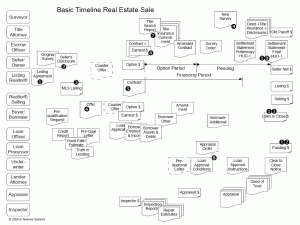The Real Estate Process
Purchase & Sale of Real Estate
The process involves a lot of participants.
Along the left side of the diagram are the major players. Time is shown roughly in the left-to-right scale, events to the left happening before those on the right.
Seller – Listing
The process starts with the seller in (1) agreeing to list her property for sale. The agreement is through a Realtor who works for a real estate broker. The listing agreement outlines how long the agreement lasts, basics on how the property will be marketed, and how much the broker will be paid if a contract for sale results.
Along with the listing agreement the seller should provide relevant other documents, such as existing Survey, the Seller’s Disclosure of conditions of the property (2). It’s best to get the survey and disclosure prior to the actual entry of the listing (3) into MLS. Multiple Listing Service (MLS) is a cooperative system that brokers participate in to see each other’s listing in a sort of master list of all available properties.
Buyer – Offer
After the property is listed, potential buyers will come with a Realtor to view it (we say the Realtor shows it). Showings eventually will bring the buyer, provided the property meets the buyer’s needs and the offered price is close enough to what the buyer is willing to pay. If so, the buyer’s Realtor will prepare an offer (4) to purchase the property. The offer is a contract ready to be signed by the seller. It describes in detail the property and terms the buyer is willing to offer.
In the dotted documents we represent the counter-offers back and forth between buyer and seller until they reach agreement. That agreement means the written offer is signed by both parties and becomes the contract (5). The agreement kicks off the rest of the process and pulls in other players to assist the seller and buyer in consummating the sale.
First, the buyer may have made the contract contingent on an inspection that he considers clear. This is usually done by an Option clause. The buyer pays an Option Fee and gets a period of time to inspect the property and make a final decision to proceed. The option fee is paid directly to the seller and she can cash it right away. The option period begins and runs from the execution date of the contract. Typically, 5 to 15 days is requested by buyers to hold the property exclusively for them while they decide on proceeding.
Second, most contracts are contingent on financing the buyer (borrower). Buyer and seller agree upfront how long the buyer will have to get approval and on what terms. If the buyer can’t get the financing as agreed, he can notify the seller and terminate the contract without losing his earnest money, but he must meet the deadline in the contract.
Third, the signed (executed) contract is delivered to the escrow officer at a title company. An attorney can also be used, but closings are commonly handled by title companies in Texas. In addition to the contract itself, the earnest money (6) is deposited with the title company into an escrow account. Earnestness is important in real estate. The earnest money is at risk, if the buyer is not really serious about closing. Of course, the option fee can compensate the seller for her time if things don’t work out. After the option period is over, the right to terminate the contract by the buyer becomes more limited.
Delivery of the contract to the title company also begins the process of researching the title (7) to find any possible issues with the ownership or claims against the property. The title company will issue a commitment to provide insurance on the title to the property, commonly called a title commitment. The research could have been from the seller side by “opening title” with a title company. The buyer is allowed to use the title company the seller picked to open title – it’s usually quicker, or he can select his own choice of title company. While this commitment and report comes from the seller side, it is destined for the buyer and his lender.
Mortgage Loan
While all this is going on, the buyer gets busy with his loan. Prior even to making an offer, the buyer should have been pre-qualified (conditional qualification) for a loan in an amount sufficient to buy the property. The buyer/borrower will get his credit report from the loan officer, who may advise dealing with derogatory items on it, or paying down some debts to increase the borrower’s ability to get a loan, or to open new lines far in advance of needing a history of timely payments to demonstrate the borrower’s willingness to pay on time.
The borrower-buyer completes his application, either without any property for a pre-approval, or with the property details contained in the contract for normal approval processing. Along with the application (1003) the borrower supplies documentation required by the lender covering assets, debts, income and monthly debt payments. This track runs separately from the title company track and independent of the inspection track.
Inspections
The buyer hires a home inspector, paying him upfront, to examine the property and report any items needing further study, such as by a foundation engineer or an air conditioning expert and so on. Some lenders require an inspection for termites or wood-destroying insects. Any deficiencies can then be negotiated with the seller prior to the expiration of the option period. If agreement cannot be reached, the buyer has the option not to proceed and simply terminate the contract to purchase. His earnest money will be refunded at this point if he elects to terminate. Usually, though, buyer and seller come to agreement on repairs that might be needed and the contract is amended prior to the end of the option period.
At this point after the end of the option period or amendment for repairs, the lender is sure that the contract will proceed to closing and the processor orders the property appraisal. The order is not normally placed before this point because appraisal fees are paid at the time of the work and cannot be refunded. In the meantime the underwriter will release any conditions required for the loan (8), divided into underwriting conditions and closing conditions. The underwriting conditions must be cleared prior to issuance of a “clear to close” and closing conditions must be cleared at the time of closing.
Hazard Insurance, Appraisal & Survey
The lender requires the house to be insured for at least a full year after closing. So, the buyer has to contact his insurance agent and ask for coverage. Usually, buyers ask multiple agents for insurance quotes and select the one they like. The buyer-borrower then notifies the loan officer or through his Realtor, notifies the title company of the name of the insurance company and the contact person. The loan officer will get the amount to be collected at closing and advise the insurance agent of the loss payable clause to be put on the policy. Sometimes the buyer pays for insurance outside of closing. Note: we call this type of insurance hazard insurance, while most people call it homeowner’s insurance.
Similar to the appraisal order, an order for a new survey is held off until the contract is no longer subject to cancellation, for the same reasons as the appraisal. The seller signs a T-47 attesting to the changes he did or didn’t make to the property that might affect the survey. This, along with the old survey, may be enough to avoid buying a new survey. The survey cost must be paid once the work is completed, but usually surveyors will accept payment from closing. The new survey (9), if required, will arrive some time before closing.
When the appraiser delivers the appraisal to the lender (and possibly the survey, too), all the underwriting conditions will have been satisfied, and at this point the instructions are sent to the title company. The escrow/closing officer prepares a preliminary settlement statement (HUD-1) and returns it to the lender for approval. The lender’s attorney (or occasionally the title attorney) prepares the deed of trust for the loan and other documents, such as loan disclosures, for delivery to the escrow officer.
The HUD & Cash to Close
The final settlement statement (10) is issued to the lender, and the buyer and seller through their Realtors. The lender then issues the “clear to close” to the title company. Buyer and seller schedule time(s) to appear at the closing table. For the buyer the amount of cash to bring to closing is shown at the bottom of the HUD-1. His Realtor advises him to bring a cashier’s check or wire money into the title company to cover the “cash to close” line on the settlement statement. Buyer sends or brings money to close (11).
Buyer and seller sit at the closing table, usually at separate times, but occasionally together or at least in adjacent time slots. If either buyer or seller or one of their spouses is out of town, then the process becomes a “mail-out” and documents are sent by email or Fedex to the remote person. The remote party signs in front of a notary and returns the documents by Fedex or express mail. This means closing is actually delayed by one business day.
Funding & Possession
The final step where the keys from the seller’s Realtor are given to the buyer’s Realtor is at funding. Funds may be committed and locked by the lender until documents are all executed. They’re unlocked after signatures. Some deals are funded to the title company’s table and distribution is faster. Funding (12) is the act of dividing up all the money to the various parties. The trust invested in the escrow officer and title company is tremendous. They have to pay off the old loan, pay the seller any remainder after deducting expenses, pay the Realtors’ brokers, and pay for hazard insurance, and then file the executed deeds with the county recorder. Note that buyer and seller could have agreed to turning over the keys (possession) either earlier or later than funding, but temporary leases like this are done in writing.
They also pay the title insurance carrier to issue the title policies they committed to for the owner and the lender. These policies usually take a few weeks to appear in the mail. Also paying off the old loan of the seller will result in a release of lien that they may file to clear the seller’s mortgage off, or the seller might have to file himself. The seller must also cancel his house insurance, which may result in a refund. Under some circumstances the seller might be entitled to a refund of certain types of mortgage insurance, such as MIP for FHA loans.
















